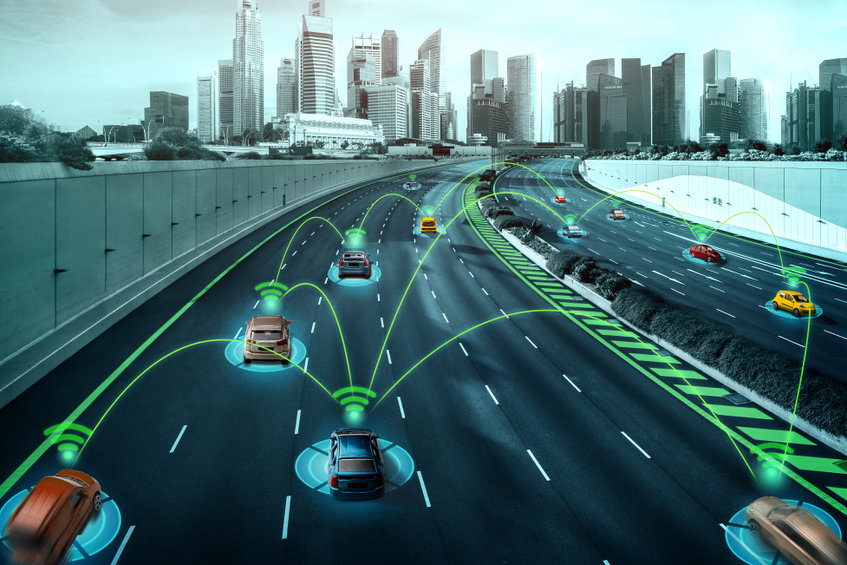DoT releases national V2X plan

$60 million in recent grants will support V2X deployments in Utah, Arizona and Texas
The U.S. Department of Transportation has officially released a national V2X plan for vehicle-to-everything communications and infrastructure, which envisions nationwide deployment of wireless technology in the 5.895-5.925 GHz band by 2036.
“Deployments utilizing V2X technologies have already demonstrated the safety benefits on a smaller scale throughout the nation,” the agency said in the plan’s executive summary. “However, to realize the full lifesaving potential of V2X technology, it is important to expand the deployment and require vehicles and infrastructure to communicate safely, securely and without harmful interference across a variety of devices and platforms. To achieve this type of ‘interoperable connectivity,’ a diverse range of mobile, in-vehicle, and roadside technologies must be able to communicate everywhere, efficiently, and securely, in a way that protects personal information.”
The V2X plan was originally released last year for public comment, and is now in its official form. DoT emphasized that its V2X plan does not come with dedicated federal funding or regulatory mandates.
“The Plan was drafted and advanced with collaboration across public and private partnerships. It provides stakeholders with vital information to enable a safe, efficient, and sustainable transportation system through the national, widespread deployment of interoperable V2X technologies. The Plan will accelerate investment, research, and deployment in V2X “market certainty,” said Principal Deputy Assistant Secretary for Research and Technology and Chief Scientist Dr. Robert C. Hampshire, in a statement.
U.S. Secretary of Transportation Pete Buttigieg called the release of the V2X plan a “key milestone,” adding: “This plan will move us closer to nationwide adoption of this technology.”
The short-term goals of the plan cover the period from this year through 2028 and include:
-V2X technology deployed across 20% of the national highway system.
-Achieving a dozen interoperable, cyber-secure deployments.
-20 grants in at least 10 states for projects that use the 5.895-5.925 GHz band.
-The top 75 U.S. metropolitan areas having 25% of intersections with traffic signals, enabled with V2X technology.
-Two vehicle OEMs committing to build vehicles with 5.895-5.925 GHz connectivity, by the 2028 model year.
However, some of those goals are predicated on another one: The Federal Communications Commission finalizing its rules on operations in the 5.9 GHz band, including transmission power levels, requirements around geofencing and so on.
The band is designated for Intelligent Transportation Services (ITS) and has been for decades; under the Obama administration, the federal government was close to declaring Dedicated Short-Range Communications (DSRC) as the technology to be used for ITS, but that effort was suspended when the Trump administration took office, then scuttled. The ecosystem, meanwhile, moved on to exploring cellular vehicle-to-everything rather than DSRC. In 2020, the FCC adopted an order that designated the lower 45 megahertz of the 75-megahertz band for unlicensed use, while retaining the upper 30 megahertz of the 5.9 band for ITS use, but left some operational details to be determined in a second report and order.
Last month, FCC Chairwoman Jessica Rosenworcel circulated a second report and order on the 30 megahertz of the 5.9 GHz band that would “codify C-V2X technical parameters … including power and emission limits and message prioritization.” In a release, the FCC said that the rules—which have yet to be approved—would allow the automotive industry to use three 10-megahertz channels separately, or aggregate them as a 20-megahertz channel or as a single 30-megahertz channel; plus establish “prioritization of safety-of-life communications.” The proposed rules grandfather existing CV2X operating waivers (which were needed because the spectrum was still allocated to DSRC) and lay out a two-year timeline for sunsetting the use of DSRC.
In a separate but related announcement, the Federal Highway Administration recently awarded nearly $60 million in grants that will support deployment of V2X technology in several states. Arizona, Texas and Wyoming are expected to serve as national models for CV2X. According to the Federal Highway Administration, those grants include:
-$19.6 million to Maricopa County’s Department of Transportation for a “largescale deployment” to connect 750 roadside units and virtual roadside units, using 5.9 GHz, to about 400 vehicle units in transmit, emergency responders and freight fleets. “The project will deploy Emergency Vehicle Preemption, Vulnerable Road User detection, Transit Signal Priority, and Freight Signal Priority applications in the Cities of Phoenix, Tolleson, Avondale and unincorporated Maricopa County, as well as along ADOT’s US 60,” DoT said.
-$19.2 million will go to the Texas A&M Transportation Institute to deploy V2X technology in the Greater Houston area, the city of College Station (including near the campus of Texas A&M University) and the travel corridors between those cities, with a focus on “holistically” improving “safety, efficiency, and overall mobility,” for first responders, transit operators, motorists pedestrians and cyclists.
-$20 million for the Utah DoT, which will actually support V2X deployments in Colorado and Wyoming as well. The U.S. DoT said that the project covers all of Utah, I-80 through the entire length of Wyoming, and major portions of Colorado, including the Denver Metro Area, I-70 from Denver to the Utah border, and I-25 through Colorado. “The applications focus on safety, mobility, and environment, and support the ability to demonstrate measurable impact and address critical needs including connected intersection, weather impact, curve speed warning, traveler information and vulnerable road user and other safety alert technologies,” according to the Federal Highway Administration.

Comments are closed.